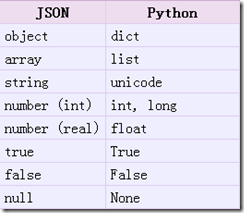JSON(JavaScript Object Notaion)是一种轻量级的数据交换格式,它使得人们很容易的进行阅读和编写。同时也方便了机器进行解析和生成,适用于进行数据交互的场景。
官方文档:https://docs.python.org/3/library/json.html
1、JSON
json简单的说就是javascript中的对象和数组,这两种结构`对象`和`数组`,可以组合起来表示各种复杂的结构。
(1)对象:对象在js中表示为{}括起来的内容,数据结构为{key:value,key:value,...}的键值对的结构,在面向对象的语言中,key为对象的属性,value为对应的属性值,取值方法为`对象.key`获取属性值,这个属性值的类型可以是数字、字符串、数组、对象这几种。
(2)数组:数组在js中是中括号[]括起来的内容,数据结构为["python,'c","java"...],取值方式和所有语言中一样,使用索引获取,字段值的类型可以是数字、字符串、数组、对象这几种。
2、import json
json模块提供了四个功能:`dumps`、`dump`、`loads`、`load`,用于字符串和Python数据类型间进行转换。
2.1 json.loads()
json.loads()把json格式字符串解码转换成Python对象,从json到Python的类型转化对照如下:

import json strList = '[1, 2, 3, 4]' strDict = '{"city": "北京", "name": "大猫"}' json.loads(strList) # [1, 2, 3, 4] json.loads(strDict) # json数据自动按Unicode存储 # {u'city': u'u5317u4eac', u'name': u'u5927u732b'}
2.2 json.dumps()
json.dumps()实现python类型转化为json字符串,返回一个str对象。
从python原始类型向json类型的转化对照如下:

import json import chardet listStr = [1, 2, 3, 4] tupleStr = (1, 2, 3, 4) dictStr = {"city": "北京", "name": "大猫"} json.dumps(listStr) # '[1, 2, 3, 4]' json.dumps(tupleStr) # '[1, 2, 3, 4]' # 注意:json.dumps() 序列化时默认使用的ascii编码 # 添加参数 ensure_ascii=False 禁用ascii编码,按utf-8编码 # chardet.detect()返回字典, 其中confidence是检测精确度 json.dumps(dictStr) # '{"city": "\u5317\u4eac", "name": "\u5927\u5218"}' chardet.detect(json.dumps(dictStr)) # {'confidence': 1.0, 'encoding': 'ascii'} print json.dumps(dictStr, ensure_ascii=False) # {"city": "北京", "name": "大刘"} chardet.detect(json.dumps(dictStr, ensure_ascii=False)) # {'confidence': 0.99, 'encoding': 'utf-8'}
2.3 Json.dump()
将python内置类型序列化为json对象后写入文件
import json listStr = [{"city": "北京"}, {"name": "大刘"}] json.dump(listStr, open("listStr.json","w"), ensure_ascii=False) dictStr = {"city": "北京", "name": "大刘"} json.dump(dictStr, open("dictStr.json","w"), ensure_ascii=False)
2.4 json.load()
读取文件中json形式的字符串元素,转换成python类型
import json strList = json.load(open("listStr.json")) print strList # [{u'city': u'u5317u4eac'}, {u'name': u'u5927u5218'}] strDict = json.load(open("dictStr.json")) print strDict # {u'city': u'u5317u4eac', u'name': u'u5927u5218'}
3、JsonPath
JsonPath 是一种信息抽取类库,是从JSON文档中抽取指定信息的工具,提供多种语言实现版本,包括:Javascript, Python, PHP 和 Java。
JsonPath 对于 JSON 来说,相当于 XPATH 对于 XML。
安装:`pip install jsonpath`
官方文档:https://goessner.net/articles/JsonPath/
3.1 jsonpath与xpath语法对比
| XPath | JSONPath | 描述 |
|---|---|---|
/ |
$ |
根节点 |
. |
@ |
现行节点 |
/ |
.or[] |
取子节点 |
.. |
n/a | 取父节点,Jsonpath未支持 |
// |
.. |
就是不管位置,选择所有符合条件的条件 |
* |
* |
匹配所有元素节点 |
@ |
n/a | 根据属性访问,Json不支持,因为Json是个Key-value递归结构,不需要。 |
[] |
[] |
迭代器标示(可以在里边做简单的迭代操作,如数组下标,根据内容选值等) |
| | | [,] |
支持迭代器中做多选。 |
[] |
?() |
支持过滤操作. |
| n/a | () |
支持表达式计算 |
() |
n/a | 分组,JsonPath不支持 |
3.2 示例
# jsonpath_lagou.py import requests import jsonpath import json import chardet url = 'http://www.lagou.com/lbs/getAllCitySearchLabels.json' response = equests.get(url) html = response.text # 把json格式字符串转换成python对象 jsonobj = json.loads(html) # 从根节点开始,匹配name节点 citylist = jsonpath.jsonpath(jsonobj,'$..name') print citylist print type(citylist) fp = open('city.json','w') content = json.dumps(citylist, ensure_ascii=False) print content fp.write(content.encode('utf-8')) fp.close()